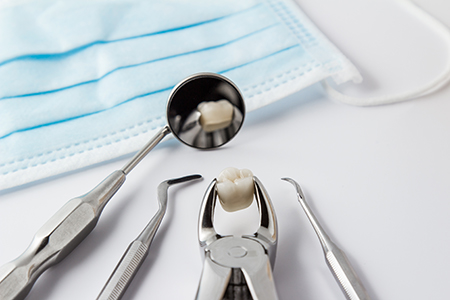
Our Office
2615 West 24th St.
Plainview, TX 79072
Existing Patients: (806) 296-6057
New Patients: (806) 217-7472
Visit Us Online

At the office of Texas Super Smiles for Kids, preserving natural teeth is always our first priority, but there are times when extraction is the safest path to protect a patient’s long-term oral health. Our team approaches every decision with careful assessment and clear communication so families understand why removal may be recommended and what to expect at each step.
Removing a tooth is often a measured decision made to stop pain, prevent infection, or preserve the development of a child’s bite. We balance conservative treatments with the realities of each case—when restorative options are no longer viable or when a lingering tooth threatens surrounding teeth and tissues, extraction can help prevent more complex problems later.
Before recommending an extraction, we review your child’s or your medical history, perform a targeted clinical exam, and take radiographs as needed. Our goal is to select the least invasive option that achieves a healthy outcome while minimizing stress and recovery time.
Primary (baby) teeth that won’t come out or are severely decayed
Sometimes a baby tooth remains firmly in place after its permanent successor is ready to erupt. This can occur when roots fail to resorb normally or the tooth fuses to the jawbone. An over-retained primary tooth can block the eruption path and cause crowding or misalignment, so timely removal may be advised to support normal dental development.
Permanents that are too damaged to repair
Decay begins on the enamel surface and, if untreated, can progress into deeper layers of the tooth. When structural damage is extensive—compromising the crown, root, or the tooth’s ability to be predictably restored—extraction becomes the most reliable option to eliminate infection and protect the adjacent teeth and tissues.
Teeth fractured beyond salvage
Trauma can produce a range of fractures from minor chips to breaks that extend below the gumline. When a fracture involves the root or leaves too little sound tooth structure for a durable restoration, removal may be recommended to relieve pain and reduce the risk of repeated infection or further damage.
Advanced periodontal disease undermining support
Periodontal disease attacks the soft tissue and underlying bone that hold teeth in place. In advanced cases, the loss of supporting bone and attachment can render a tooth unstable or hopeless. Extracting such teeth can improve oral health and make subsequent periodontal or restorative treatment more predictable.
Problematic wisdom teeth
Third molars often erupt with limited room and can become impacted, decay-prone, or a source of pressure on neighboring teeth. In children and young adults, removing problematic wisdom teeth before they cause damage is a common preventive strategy; older patients may require extraction when symptoms or complications arise.
Extractions as part of orthodontic planning
When the jaws lack space for all the permanent teeth, selective removal of one or more teeth may be part of an orthodontic plan to achieve proper alignment and a stable bite. These decisions are made in coordination with the orthodontic goals for function and aesthetics.

Every extraction begins with a thorough review of health history and a clear explanation of the procedure. We ask about medications, allergies, and any recent illnesses because certain conditions can affect healing or the need for special precautions. When appropriate, we coordinate care with a patient’s physician to ensure the safest possible outcome.
Imaging—typically a digital radiograph—helps us evaluate root shape, bone levels, and the relationship of the tooth to nearby structures. That assessment determines whether the removal will be straightforward or require a surgical approach. We also discuss anesthesia and comfort options; local anesthesia is standard, and additional sedation may be offered for anxious patients or more complex cases.
Communication is central to our approach: you’ll be told exactly what to expect before, during, and after the procedure. We provide step-by-step instructions and answer questions so parents and patients feel confident and prepared.
Simple extractions are performed when the tooth is fully visible in the mouth and root anatomy is favorable. After numbing the area with a local anesthetic, the clinician gently loosens the tooth with instruments and uses forceps to remove it. The process is efficient and typically results in minimal recovery time when postoperative guidelines are followed.
Surgical extractions are indicated when a tooth is broken at the gumline, impacted, fused to bone, or otherwise inaccessible with routine instruments. This procedure may involve a small incision, the careful removal of a modest amount of bone, or sectioning the tooth for safe removal. For certain surgical cases, we may refer to or consult with an oral and maxillofacial surgeon to ensure optimal care.

Recovery varies by procedure, but most patients do well following simple extractions when they adhere to basic care principles. We supply tailored aftercare instructions based on the type of extraction, the patient’s age, and any medical considerations. The first 24 to 72 hours are the most critical for clot formation and initial tissue healing.
Keep activity moderate, follow medication directions if they are prescribed, and avoid anything that could dislodge the clot at the extraction site. Good pain control and attentive home care significantly reduce the chance of complications and support a smooth recovery.
We encourage families to monitor the healing process and contact our team if they observe excessive bleeding, persistent or worsening pain, fever, or any signs of infection. Timely follow-up allows us to address issues quickly and effectively.
Keep firm pressure with gauze as directed
Immediately after the extraction, bite gently but firmly on the gauze pad provided to encourage clot formation. Replace the pad as instructed—typically after the first hour—and continue holding gentle pressure if bleeding persists. Some light oozing can be normal for up to 24 hours.
Protect numb tissues
Stay mindful that lips, tongue, and cheeks may remain numb for a few hours after anesthesia. Avoid chewing or touching the area until sensation returns to prevent accidental injury.
Take medications exactly as recommended
Antibiotics:
If prescribed, take the full course to reduce the risk of postoperative infection.
Pain control:
Begin pain medication as recommended—starting while the anesthetic is still active can prevent discomfort from rising. Use over-the-counter or prescription analgesics only as directed.
Protect the clot
Avoid actions that could dislodge the blood clot, such as spitting, rinsing vigorously, using a straw, or smoking, especially during the first 48–72 hours.
Control swelling with cold packs
Apply ice externally to the cheek in short intervals during the first day to manage swelling. Elevating the head while resting can also reduce inflammation.
Avoid tobacco
Smoking and other tobacco use impair healing and increase the risk of dry socket and infection. Refrain from tobacco for at least one week after the extraction whenever possible.
Choose gentle foods
Soft, non-spicy foods and cool or lukewarm beverages are easiest to tolerate in the days following an extraction. Gradually return to a normal diet as comfort allows.
Keep oral hygiene gentle
Continue regular brushing, taking care to avoid the extraction site for the first day. After 24 hours, a mild saltwater rinse can help keep the area clean—avoid vigorous swishing.
Attend any recommended follow-up
If sutures were placed, or if the extraction was complex, we will schedule a follow-up appointment to check healing and remove sutures if needed. Please keep this visit so we can confirm recovery is progressing well.
If you notice unusual symptoms—such as persistent heavy bleeding, new numbness, escalating pain, or signs of infection—please contact our office promptly so we can evaluate and guide next steps.

Removing a tooth can improve comfort and oral health, but patients and families understandably want to know about replacement options. The right timing and choice depend on age, growth, the location of the missing tooth, and overall dental needs. In many cases we plan restorations to maintain function, preserve bone, and support long-term oral health.
Options commonly discussed include removable partial dentures, fixed dental bridges, and dental implants. Each approach has advantages and specific indications—implants provide a fixed solution that supports bone preservation, bridges replace missing teeth when adjacent teeth are suitable, and removable solutions can be a conservative way to restore appearance and chewing while other considerations are addressed.
For growing children, we often recommend interim solutions until skeletal development is complete. Our team will explain the pros and cons of each option and coordinate with specialists when necessary so families can make informed choices that align with both short- and long-term goals.
Texas Super Smiles for Kids combines pediatric expertise with a family-friendly approach that emphasizes comfort, communication, and safe, evidence-based care. Our clinicians are experienced in working with children and adults, tailoring treatment plans to meet developmental and medical needs while prioritizing emotional well-being during procedures.
We focus on thoughtful preparation—reviewing medical history, discussing anesthesia and sedation options when appropriate, and providing clear, easy-to-follow aftercare guidance. That preparation helps reduce anxiety and supports predictable healing for most patients.
When a referral is in the patient’s best interest, we coordinate closely with oral surgeons and other specialists so transitions in care are smooth and fully informed. Our commitment is to provide responsible, compassionate treatment that protects oral health now and into the future.
In summary, extractions are sometimes the most appropriate solution to prevent pain, stop infection, and protect developing smiles. If you’d like more information about tooth removal or want to discuss whether an extraction is the right choice for your child or yourself, please contact us for more information.
The most common reasons for tooth loss include advanced periodontal disease, extensive tooth decay, and facial trauma. According to statistics, gum disease is responsible for close to 70% of tooth loss in adults. Although less frequent than the preceding three reasons, it should also be noted that specific diseases, drugs, smoking, and poor nutrition contribute to the risk of tooth loss.
The Centers for Disease Control and Prevention report that in the United States, an average of 12 teeth (including the wisdom teeth) are lost by the age of 50. Also, 26% of adults between 65 and 74 years of age have lost all their teeth.
Every patient and every situation is different. However, when a tooth and the surrounding tissues are numbed with a local anesthetic, you should only expect to feel a bit of pressure, but no pain as the tooth is being loosened from the surrounding tissues and extracted. For patients who are apprehensive and for some surgical extractions, our office will discuss our options in dental sedation to provide further relaxation and reduce any sense of discomfort.
While it's normal to feel some tenderness and swelling following an extraction, the degree of these sensations can vary. It mostly depends on the complexity of the extraction and the body's response to the procedure. We'll recommend or prescribe the appropriate pain medication to help ensure your comfort and give you specific instructions for maximum effectiveness and safety.
Typically, the recovery period following a simple extraction is shorter than a surgical extraction. However, a patient's overall health, habits, the size and location of the tooth, and other variables can influence recovery and healing. To speed up the recovery and avoid any complications, patients must follow the given at-home instructions diligently. We'll carefully review what to expect following your procedure and go over your post-op instructions.
Smoking interferes with blood clot formation, which is an essential first step in the healing process. Blood clot formation not only provides a protective layer to cover the underlying exposed bone and nerve endings, but it also supports the growth of new tissue. Cigarette smoke also contains chemical toxins that can disrupt the healing process and lead to problems such as continued inflammation, infection, or dry socket.
In a very small percentage of cases, a condition known as dry socket can develop in the aftermath of a dental extraction. This painful condition can arise when the blood clot in the extraction site doesn't form properly or gets dislodged. With dry socket, you may experience throbbing pain and symptoms such as bad breath and an unpleasant taste in your mouth. As skilled providers of care, our office will provide immediate treatment to alleviate your discomfort and promote healing.
The last teeth in your mouth to develop, wisdom teeth often do not have enough room to fully erupt or may be positioned in the wrong direction. These issues can affect your dental health as well as overall wellbeing. While some individuals never develop all their wisdom teeth, and a few have sufficient space for them, there are many people with partially or fully impacted third molars. Our office will monitor the development, position, and health of your wisdom teeth and will advise you if and when extractions are indicated.
After a tooth is removed, bone-grafting material is sometimes placed in the socket to promote healing and encourage new bone development. This procedure is often performed to support the eventual and successful placement of a dental implant.
At the office of Texas Super Smiles for Kids, we strive to make dental care affordable and accessible. Depending on the type or complexity of the extraction and other variables, the cost of the procedure can vary. Based on our diagnostic findings, our office will inform you of the healthiest choices in care, explain the fees, discuss insurance coverage, and explain your payment options.
Many dental plans offer some level of coverage for tooth extractions. We'll advise you if your plan covers the full cost of the procedure and if there is any out-of-pocket expense. Our business office will work with you to maximize your insurance benefits as much as possible while helping you minimize any out-of-pocket expenses.
